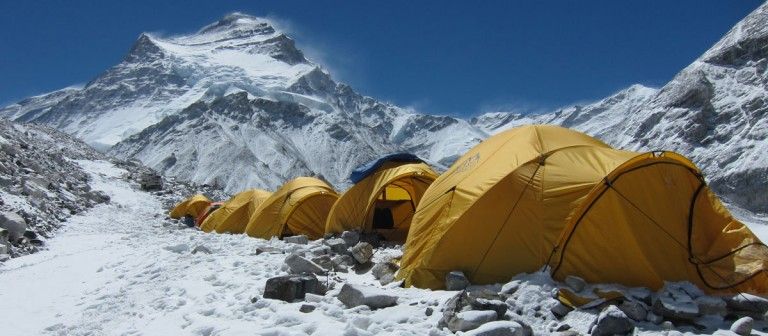A Project Managers “Climbing Expedition”
Posted on July 2014 By Andrea Rigotti

I am a SAP Project Manager and have worked in several engagements with Speller International. In my spare time, I love to climb 8,000m mountains in Tibet and Nepal. “Why do you do it?” is probably the most common question I am asked by customers, colleagues and friends alike. Before answering the question, I’d like to share with you my “Project Manager” take of an 8,000m expedition: I am sure you will be blown away by the incredibly high number of similarities with a classical SAP project.
Let’s start from something dear to Speller International: Recruiting talent. If you are applying for a job as Expedition Leader (in SAP terms, the Project Manager) here’s what your job description may look like.
“The successful applicant will be responsible for ensuring that the customers (the climbers) will reach the summit of the mountain and return home in absolute safety. Exposed for several weeks to extreme weather conditions, temperatures will be as low as 60c below zero, with winds of up to 160km/h. You will experience lack of oxygen concentration (as little as 20.9% of what you breath at sea-level altitude), and random but frequent rock falls and avalanches. Known risks are frostbite, potentially causing amputation of limbs, broken bones or, worst case, death. To guarantee your customer’s wellbeing you will need to make sure they have enough oxygen, gas for cooking and food for up to 7 weeks (plus contingency)“.

Great, are you ready to apply for this position?!
Like any SAP Project, the Expedition Leader’s work begins well before reaching base camp (BC). The leader needs to take care of the logistic preparation of the expedition, ensuring that the climbers have a valid climbing permit for a specific mountain. They need to organise the various transport methods that will ensure equipment and people will reach BC. In most cases, BC is at least a few days away from the closest village, there are no sealed roads, hence the transportation of goods mostly happens using animals (e.g. camels, yaks, donkeys) and local porters. A Yak costs you $200 and will carry a maximum of 50kg, while a local porter will carry up to 40kg for $3/kg. A “normal” climbing group comprises of 10 climbers, 1 cook, 1 kitchen aid, 1 kitchen boy, 6-7 climbing Sherpa. Each climber has approximately 40kg of personal technical gears (e.g. ropes, down-suits, harness, ice axe, etc.). In addition the climbing team need a dining tent, a shower tent, a toilette tent, a tent for each climber, and 1 tent for each 3 staff/Sherpa’s. Are you lost with the number and size of the climbing party? Let me summarise it for you: including food, gas and oxygen, an expedition carries a total load of approximately 6,000kg. In my last trip we travelled with 22 yaks and 127 porters. As Expedition Leader you need to book these resources in advance, pay them daily (and ensure you keep tracking the costs), ensure you have a contingency plan if something happens (e.g. porters getting sick due to high altitude, food poisoning and hence abandoning the expedition and the load they carry somewhere on the way).
It is only after the logistics are taken care of that the climbers enter the “Design Phase” (keeping with the SAP terminology) or in mountaineering words, the whole expedition party settle into BC, and commence the acclimatising phase. The Expedition Leader immediately sends the Sherpa’s up the mountain to scout/verify the route, secure it with fix ropes and, often, to report back to the clients some areas of concerns (e.g. difficult icy sections or dangerous areas prone to avalanches) and suggest alternative solutions/routes. In addition, the Expedition Leader schedules a group of porters to walk back multiple times to the closest villages in order to buy fresh supply of veggies, meat and other goods like sugar and flour, so that the climbers can always enjoy fresh, healthy and nutritional meals. It is estimated that during a rest day at BC every single climber consumes approximately 6,000 calories (average daily requirement at sea level is approximately 2,000 calories for an adult), translating in a lot of food consumed at BC over the duration of the expedition.

Once the routes are agreed between the Sherpa’s and climbers (and that the route has been secured with fix ropes) the team is ready to start the acclimatising phase (the SAP “Build/Test” phase). This is the stage when climbers finally start doing what they know best, climbing! The acclimatising phase for a 8,000er will take approximately 5-6 weeks depending on the mountain (e.g. Everest takes a couple of extra weeks). During this phase the Expedition Leader prepares a “detailed schedule” and determines individual climbing plans. Because every climber has their own pace and fitness level (and health conditions vary quite significantly), the Expedition Leader will team up climbers with similar speed and ability. In addition, as a “Project Manager” they will pair-up the best climbing Sherpa (your SAP Functional Team Leader) with the weaker climber, so that safety risks are minimised. As a consequence, it is completely normal to have multiple teams of climbers simultaneously climbing different sections of the mountain. For instance, a team may be moving from C1 to C2, while another team may be moving from C2 down to ABC (Advance Base Camp). Two teams may be resting at BC with plans to leave for higher camps in a day or two.
Sudden changes in weather conditions have huge impacts on the safety of the teams, so it is the Project Manager’s job to constantly check the weather forecast. On average, a team receive daily weather forecasts from at least 4 different service providers (including the Bureau of Meteorology in Australia). Each forecast provide an impressive amount of data (e.g. wind speed, snow fall, temperature and humidity, each at various altitudes) normally with a view by hour and for a range of 6 days. The data from various provider are crunched (manually, no BI available!) and a “normalised” report is communicated via radio to the different teams resting at the different camps at a predetermined time of the day (normally 6pm). “Communication” is key – up the mountain as well as on SAP Projects. It is the Expedition Leader’s job to ensure that every climber knows what to do, by when and understands the situation (e.g. weather) surrounding them. It is not unusual for the Expedition Leader to ask climbers to change their plans (e.g. push to C2 rather than resting, or come back to BC rather than going to C3) because of changed meteorological conditions and in order to ensure climbers safety and the chance to reach higher summits.

Fast forward 40 days, and after weeks of climbing the mountain at various altitudes, at various speeds, the climbers are fully acclimatised and ready for the summit push. Food, oxygen and gas tanks are in positions at the various camps. This is the exciting part of the expedition where all the hard work and preparation will come to fruition. It is show time, baby! During this important phase of the expedition, the Expedition Leader is monitoring every event up the mountain sometime working on a 24/7 shift for a few days. There are teams moving at night to minimise risks of avalanches or rocks falling, while other teams are moving during the day enjoying higher temperatures. During the summit push, the Expedition Leader, exactly like any SAP Project Manager, is ultimately the person making all critical decisions (e.g. when a climber MUST turn around) but every member of the team play an important role for the success of the expedition. It is an extremely intense time, similar to a Deployment/Go Live phase, but great satisfaction, joy and various rewards await those who will be successful. Some teams will summit, some teams will come back without a summit, some climbers will return to the base ready to party while some others will have nothing to celebrate and plenty of injuries. Exactly like we see in our line of business, some SAP projects will go live while other projects will have to roll-back and lean on a Business Continuity Plan. When the dust settles and the climbers return to BC, it is time to organise the logistics for the return trip, including the increasingly important disposal of the human waste and rubbish. The end of the expedition is approaching, and, like in every good SAP project, there must be an “Expedition wrap up party” (“Go-live party in SAP terminology), but that’s where my blog ends because as we have learnt from the Speller International Christmas Party, what happens in Vegas stays in Vegas.
Oh, I almost forgot. “Why do I climb” you asked?
I climb because to those who have struggled with them, the mountain reveals beauties that they will not disclose to those who make no effort. If you think about it, our whole existence revolves around climbing: we climb towards a higher social position, a better life, a happier existence or a better job. In the mountains there is the promise of something beautiful and unexplainable. So we climb and in climbing there is more than a metaphor of life; there is a means of discovery not just a beautiful environment, but ourselves. Away from the watchful eye of our peers and society, climbers make life changing decisions: to help a fellow climber in danger and forfeit a glorious summit, or go for personal glory and let another human being die? For weeks climbers live deprived of every comfort, away from the love of their families, with no running water, no remote control, in harsh environmental conditions, mostly wondering if today will be their last day alive. And there, in such harsh conditions, they truly discover who they are and where they really are in life. Somewhere, between the bottom of the climb and the summit is the answer to the mystery of why we climb.

